Fish hatcheries have become ever more important in recent years due to the declines in wild stocks. The aim of hatcheries is to replenish the wild stock in order to keep the fishing industry sustainable, but there is still debate as to what is the best approach to this without causing further damage to the wild population. In an attempt to make improvements to hatchery practices, Hitoshi Araki studied the reproductive success of hatchery trout compared to wild trout, and made suggestions in his paper Hatchery Stocking for Restoring Wild Populations: A Genetic Evaluation of the reproductive Success of Hatchery Fish vs. Wild Fish (2008).
The hypothesis was that fish bred using the traditional hatchery methods, in which the fish are usually non-local and are bred for many generations in captivity, have much lower reproductive success than both supplemental hatchery fish and wild fish. The idea behind supplemental hatchery methods is to use local parent fish to breed “wild stock” hatchery fish in a protected environment, and then release them into the wild population, with the overall goal being to re-create a sustainable wild population. Using DNA analysis of steelhead trout from the Hood River, Araki determined the reproductive success of traditional hatchery fish, supplemental hatchery fish, and wild fish. He found that the more generations bred in a hatchery, the less reproductively successful the fish are.
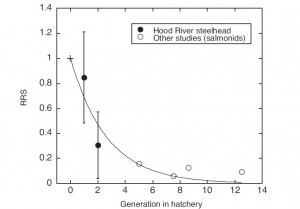
Picture 1: Araki used his own data and data from previous studies to show the decline in relative reproductive success (RRS) as the number of generations in a hatchery increased.
Araki also found that supplemental hatchery fish had significantly higher reproductive success than the traditional hatchery fish, though they still had lower reproductive success than the wild population. When a wild stock parent was crossed with a traditional hatchery parent the reproductive success dropped. This shows the effect that hatchery fish can have on the wild population. If traditional hatchery fish continue to be released into wild populations in attempt to sustain them, they will continue to lower the reproductive success of the wild population.
It seems that, though hatcheries have a positive sustainability goal in mind, the traditional methods they are using to replenish wild stocks are somewhat counter-acting what they are trying to achieve. Though it may be more work to implement supplemental hatchery methods, the benefit of higher reproductive success of the population should be worth it.
Araki used steelhead trout as his example organism, but it is assumed that similar principles could apply to other fish species. In the San Juan and Vancouver Island area, salmon hatcheries are an important part of the fishing industry (and produce important food for the Southern resident orcas!). Since Chinook salmon are endangered in the area, a large amount of juveniles are released into the wild from hatcheries. From the information I could find, it seemed hatcheries in the area are attempting to use methods closer to supplemental techniques rather than the traditional methods. For example, the San Juan Enhancement Society in Port Renfrew, BC collect their broodstock (parent fish) of Chinook from a lake connecting to the San Juan River, therefore the juvenile fish are being released into their natural habitat. Though it isn’t stated how many generations are produced in the hatchery, it still could be considered a step in the right direction compared to using a non-local broodstock. Hopefully in the future hatcheries move towards supplemental practices so that the wild stocks, the ecosystem, and everyone utilising the fish can further benefit from sustainable fish populations.
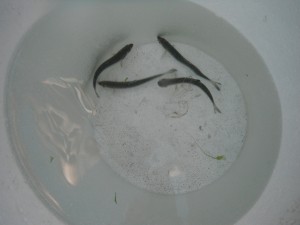 Picture 2: Both wild and hatchery juvenile Chinook can be found in the San Juan Islands, as our Beam Reach class found out while beach seining on Lopez Island. The hatchery salmon had their fins clipped for identification.
Picture 2: Both wild and hatchery juvenile Chinook can be found in the San Juan Islands, as our Beam Reach class found out while beach seining on Lopez Island. The hatchery salmon had their fins clipped for identification.
Read More
Isn’t it great having it warmer longer and being able to soak up the sun longer once summer is over?! Maybe you know the reasons from various classes or the news. Besides hearing how high CO2 levels are do you actually know how CO2 levels are affecting organisms physically? CO2 is like a fish drug that is affecting their olfactory systems and desensitizing fish to instinctive behaviors.
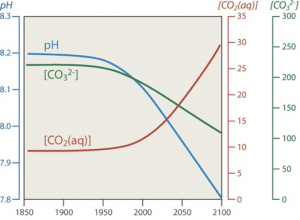 A brief background – Ocean inhabitants, especially coral reef inhabitants, are sensitive to changes whether it is temperature, CO2 concentrations, or pH. If CO2 levels continue to increase as they are, by the end of the century, there would be about 1,020ppm of atmospheric CO2 (more than enough to dramatically affect multiple marine organisms). Atmospheric and dissolved CO2 levels are linearly correlated. If atmospheric CO2 increases, dissolved CO2 in the ocean increases simultaneously. CO2 and pH levels are indirectly correlated. If dissolved CO2 increases, pH decreases. If maintaining down the current path, oceanic pH would decline up to 0.4 units, making the ocean even more acidic.
A brief background – Ocean inhabitants, especially coral reef inhabitants, are sensitive to changes whether it is temperature, CO2 concentrations, or pH. If CO2 levels continue to increase as they are, by the end of the century, there would be about 1,020ppm of atmospheric CO2 (more than enough to dramatically affect multiple marine organisms). Atmospheric and dissolved CO2 levels are linearly correlated. If atmospheric CO2 increases, dissolved CO2 in the ocean increases simultaneously. CO2 and pH levels are indirectly correlated. If dissolved CO2 increases, pH decreases. If maintaining down the current path, oceanic pH would decline up to 0.4 units, making the ocean even more acidic.
Munday et al. conducted a study to see the effects CO2 levels have on fish populations. This study was looking at clownfish and damsel fish larvae and how they respond to three different levels of CO2. The control was current CO2 levels (390ppm), 550ppm, 700ppm, and 850ppm. Behavioral responses and olfactory cues from predators were noted and it was noticed how drastic the effects of CO2 levels really were. With each increasing dosage the results were more significant. Natural and instinctive behaviors are thrown off due to the destructive influences CO2 has on the olfactory system. Instead of smelling predator cues and hiding, the increased CO2 levels cause clownfish and damsel fish to be less sensitized and alert. The fish participated in increasingly risky behavior such as spending more time where predator cues were present, swimming farther from the protections of the reef, and being more active but less alert to predator cues.
The longer a fish is exposed the worse the symptoms. Age also increased the severity of the symptoms. Noting the same change in behaviors another experiment was conducted with predator encounters. The more frequent, careless, and risky behaviors became the higher mortality rate climbed.
Not only do rising CO2 levels cause concern for species, but trying to sustain the species at risk becomes more complex. Protecting an ecosystem may no longer be enough if fish are being easily preyed upon due to the severe behavioral effects of increasing CO2 levels. Assuming other marine species will exhibit similar responses, the effects of rising CO2 on biodiversity of marine ecosystems could be significant and the effects irreversible.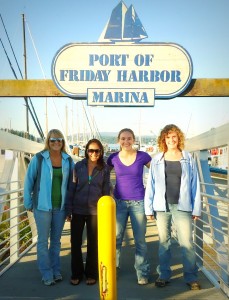
Chinook salmon are already endangered and, if the hypothesis is correct, the increasing dissolved CO2 levels could be an additional threat. Chinook, being the Southern Residents primary food source, may have a crucial impact on the killer whales if they cannot handle the added stress from rising CO2 levels. Will the Southern Residents adapt to the CO2 levels or will they suffer as much as the Chinook and other marine organisms?
The 4 students in the Fall 2011 session, along with past and future students, will study the environment and see how different factors affect the killer whales. Students are looking at relationships between the whales and salmon, human influences, and natural influences. We all start our first expedition Sunday (18th) to start collecting data for our final projects. Watch for our final projects as time moves forward!
Read More
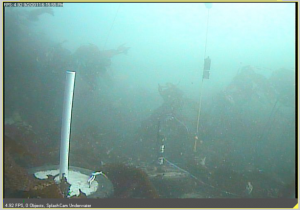
CPOD stand, hydrophones, and Vemco receiver
In collaboration with The Whale Museum, including Research Curator Stefan Bräger and Board member Jason Wood, the fall Beam Reach class has been studying fish and porpoises from the Lime Kiln State Park lighthouse. We’ll be posting results as they accrue, but for now this screengrab shows new instruments from the perspective of the Beam Reach underwater video “Splashcam.” On the left is a stand for 3 CPOD porpoise click detectors (now deployed) provided by Jim Thomson of UW/APL; in the middle are cleaned up hydrophones; on the right is a Vemco fish tag receiver deployed as part of a project led by UW’s Tom Quinn and NOAA’s Kurt Fresh.
The fall class has been surveying the ocean near Lime Kiln for harbor and Dall’s porpoises, monitoring the underwater camera for fish, measuring water properties, and sampling the plankton.  Surprises have been seeing seals and salmon swim by underwater just outside the kelp adjacent to Lime Kiln Point.
Read More
During the spring 2011 program Carlos Javier Sanchez chose to make Beam Reach a focal point of his final project as a Master of Communication in Digital Media at the University of Washington (UW). Carlos spent many weeks documenting our 10-week program — both on land at the UW Friday Harbor Labs and at sea on our sailing research vessel, the Gato Verde.
Embedded below are the fruits of his labor — a highlight video and some shorts. We look forward to continuing to work with Carlos as a Digital Content Producer and thank him here for all of the amazing footage, still imagery, and in-air recordings he captured for us.
Beam Reach overview video
Beam Reach is an off-campus adventure that lets advanced undergrads and recent graduates live the life a marine biologist. It’s a 10-week taste of what it’s like to be a graduate student or a professional field scientist.
The cold plunge off the Friday Harbor Labs dock
Beam Reach Cold Plunge 2011 from Carlos Javier Sanchez on Vimeo.
Knotcraft: the sheetbend, bowline, and clove hitch
Gato Verde Adventure Sailing captain, Todd Shuster, teaches Beam Reach Students how to get knotty.
Beam Reach is an off-campus adventure that lets advanced undergrads and recent graduates live the life a marine biologist. It’s a 10-week taste of what it’s like to be a graduate student or a professional field scientist.
Captain Todd Shuster has been involved in sailing education for over 20 years. Todd is a US Coast Guard licensed Captain, a USSAILING instructor and instructor trainer. He has taught wilderness sailing courses in Baja, Mexico for The National Outdoor Leadership School (NOLS), and has run several sailing programs for universities, yacht clubs, and summer camps.
Learning to sail a 42′ catamaran
Gato Verde’s captain, Todd Shuster, teaches Beam Reach students how to sail on the Salish Sea.
How to get up to the modern-day crow’s nest
Mandy Bailey rises above the rest.
Read More
This looks like a fun (and free!?) opportunity for Beam Reach alumni or prospective students to a week of field research experience in Scotland this fall. There’s only 10 days before the application deadline, so hurry if want to learn about cetacean (mainly bottlenose dolphin) census, behavioral observation, marine mammal rescue techniques.
Read More
Four new student papers and presentations are now posted on the spring 2011 class home page as PDFs and on-line videos. The titles of the student projects are listed below, along with the embedded video of their 10-15-minute talks.
- Introduction by Scott Veirs and Robin Kodner
Introduction by Scott Veirs and Robin Kodner to final presentations of the spring 2011 program at the Beam Reach Marine Science and Sustainability School, including first showing of a highlight video by Carlos Javier Sanchez (streamed and recorded on 6/3/11 at the University of Washington’s Friday Harbor Laboratories)
- Variation in Southern Resident Killer Whale Acoustic Signals in Relation to Environmental Factors (Mandy Bailey, University of Maine)
Final presentation by Mandy Bailey of the spring 2011 program at the Beam Reach Marine Science and Sustainability School (6/3/11 at the University of Washington’s Friday Harbor Laboratories)
- Bottom-up Analysis of Lower Trophic Levels within Foraging Areas of the Southern Resident Killer Whales (Kelsey Donahue, Western Washington University)
Final presentation by Kelsey Donahue of the spring 2011 program at the Beam Reach Marine Science and Sustainability School (6/3/11 at the University of Washington’s Friday Harbor Laboratories)
- Variation in the S1 Call Type of Southern Resident Killer Whales (Emalie Garcia, Texas A&M University)
Final presentation by Emalie Garcia of the spring 2011 program at the Beam Reach Marine Science and Sustainability School (6/3/11 at the University of Washington’s Friday Harbor Laboratories)
- Determining the correlation between call frequency and matriline density in Southern Resident killer whales (Ally Meyer, University of Washington)
Final presentation by Ally Meyer of the spring 2011 program at the Beam Reach Marine Science and Sustainability School (6/3/11 at the University of Washington’s Friday Harbor Laboratories)
Read More
Today was the day of our final presentations. After a solid week of limited sleep (one night I went to bed at 3:30 AM, and I was the first one) and lots of work, it’s a relief to finally have all that stress lifted off our shoulders. It’s given me a chance to really think about our time here. It’s had its ups and downs. When you’re living in a confined space for an extended period of time with the same people, morale can quickly spiral downwards. The final deadline looming over our heads definitely made for some stress. However, most of our boat life was extremely enjoyable. It won’t be the stressful times that we’ll remember when looking back on this trip, it will be all the times that we really enjoyed. There are a lot of things that I will really miss:
1)     Rough seas. The was nothing quite like sitting on the trampoline, rising up on the crest of a large wave only to watch with mild horror as the water simply disappeared underneath you for a minute before rushing up to soak you before you had a chance to even comprehend what’s going on. Rough seas were also fun in the cabin. Whenever Captain Todd yelled in, “You might want to hold on and secure loose items,†a frantic response was initiated as everyone rushed to grab onto their possessions. Then the boat pitched and wreaked more havoc on the galley than a small earthquake. Sure, it could be nauseating. But as long as your computer didn’t crash to the ground (which did happen on more than one occasion), you couldn’t help but laugh.
2)     Sitting out on the trampoline. It was definitely my favorite place on the boat. It was also a great place to nap. It was so relaxing sitting out there, scanning the water for whatever might be out there.
3)     How sweet chocolate tasted on the boat. I swear, chocolate never tasted so good. Especially those NOLS malt balls.
4)     Finding shrimp swimming around in the toilet. I kid you not, it happened. Then you’d have to scoop him out because you didn’t want to condemn him to a miserable death in the sewage tank.
5)Â Â Â Â Â Stirring up the water out the escape hatch at night and watching the Noctiluca produce bioluminescence.
6)Â Â Â Â Â How gorgeous the stars were every night.
7)     Calling every whale watch operator we could think of in the morning in a desperate attempt to find the whales. These calls would sometimes turn into very pleasant chats, and we all made friends with the operators.
8)     Being able to plot our own course every day. If we wanted to go around Whidbey Island, we could. And did.
9)Â Â Â Â Â How good a hot shower felt after a week of feeling cold and dirty all the time.
10)Â Sea hair.
11)Â Discovering new plankton names that sound like dinosaurs.
12) How cold it was every night… oh wait, no I won’t miss that.
13)Â The Aladdin lamp.
14) How beautiful everything out here is. We had the opportunity to visit so many awesome places, from Deception Pass to Active Pass way up in Canada. Each adventure was more exciting and beautiful than the last.
15) Home-cooked popcorn. Who knew it was so much better than microwave popcorn?
16) The whales, of course. Let me tell you, there is nothing more exciting than seeing that first blow and then getting to spend hours with these amazing animals. To make it even better, we got to listen to them underwater as we were observing them above water as well. Every day that we spent with the whales became my “best day ever.â€
17) All the amazing people that I met. I’d like to give a special thanks to all of the guest speakers that took time out of their busy schedules to meet with us. It’s been amazing. Also, to Ally, Emalie and Kelsey for helping to make this experience fun. I’ll miss them all terribly, and hope that I’ll get to see everyone again sometime in the future.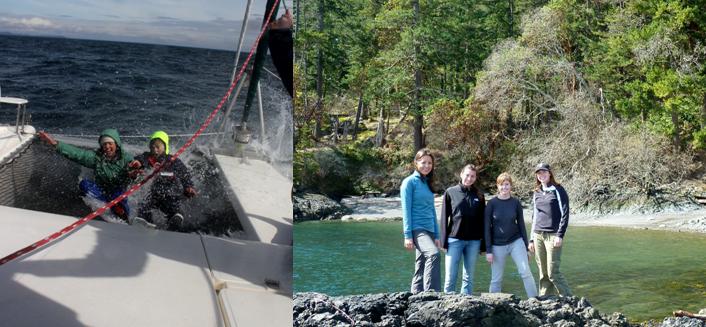
This program has been a really great opportunity. It has given us an intimate taste of what field research is like, and has definitely helped me to shape my future path. We’ve all learned so much, and I’m excited to be able to share this newly acquired knowledge with others. For a really great video on Beam Reach made by our fantastic videographer, Carlos, check this out. It’s a good summary of our experience.
I’ve wanted to study whales ever since I was three years old and first watched the movie ‘Free Willy’. I was extremely lucky to get the opportunity to actually do this. If you ever get such an opportunity to follow your dream, go for it. You never know what you might find.
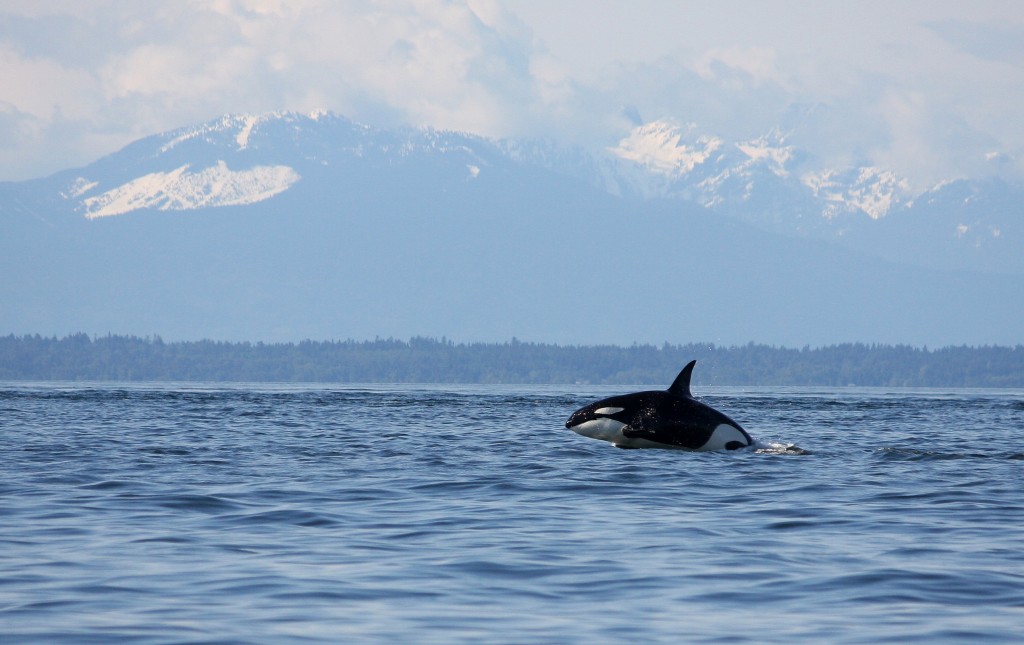
Transient orca

Read More
I’m sure you all are wondering if we’ve seen any whales these past few weeks. At this point I’m thrilled to say we have seen them more than a few times! Initially, it seemed that the whales were avoiding us or at least choosing the exact opposite direction and side of the San Juan Islands in relation to wherever we were. Days past with this sense of disappointment but determination kept us going. Our lingering hope led us to venture far into northern and southern parts of the Salish Sea. One day, we travelled up to my favorite island so far; Patos Island, in hopes the reported killer whale’s up in Pt. Roberts, Canada would continue on one of their annual routes down south between Patos Island and Eagle Point. 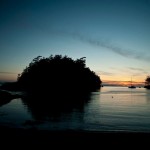 After taking night shifts listening to underwater hydrophones that are located throughout the islands we woke up the next morning knowing that they whales hadn’t passed our location. The day ended with news the whales were transients and going at a slower pace then expected. We were unable to see any whales that day, but our efforts continued nonetheless.
After taking night shifts listening to underwater hydrophones that are located throughout the islands we woke up the next morning knowing that they whales hadn’t passed our location. The day ended with news the whales were transients and going at a slower pace then expected. We were unable to see any whales that day, but our efforts continued nonetheless.
Another day we travelled an even farther distance south around Whidbey Island. Supposedly we were the first Beam Reach course to go this far south! We had heard that J pod was seen down in that area so we spent the day looking and found gray whales and a breaching Minke instead! This is very rare to see a Minke breach so our long trip down ended up being worth the time and fuel used.
I feel like I haven’t explained how exactly we go about finding the whales. I make it sound  as if we use underwater hydrophones as our main locating source, but this only half of our method! One part is to check to see if killer whale call spectrograms were picked up from the Lime Kiln underwater hydrophone if necessary, or listen to the hydrophones that stream live on orca sound at http://www.orcasound.net/ to see if we can locate the direction the whales are travelling. Our other main locating source is communicating with people. We keep in contact with land based observers, Vancouver, Victoria and San Juan Island whale watching boats, along with other companies such as the Whale Museum, the Whale Research Center, Sound Watch and Strait Watch. Each contacts purpose is either to educate boaters on vessel noise and how it can negatively impact whale communication, educate and entertain the public about their general biology or to continue research on the Southern Resident killer whale’s.  All of these contacts serve as vital source for our knowledge of the southern resident and transient killer whale location. In order for us to create an equal sharing of information relationship with these contacts we try and relay any information of what marine mammals we see on our daily routes. There are exceptions when there is the concern of overcrowding the whales, so we make it a point to be very careful about who we relay the information to.
For the past 4 weeks the information we have been able to provide for others is actually not about finding the Southern Resident killer whales.  When pulling out of Snug Harbor along the west side of San Juan Island on May 8th. Ally  spotted a humpback whale! Not only did we see a humpack whale but we caught them in a playful state allowing us to see the giant mammal breach multiple times! The amazing photo below was taken by our photographer/video-augrapher Carlos Sanchez.
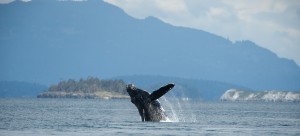
There was also pectoral and chin slapping that occurred. After our initial shock of observing a humpback breach not too far from our catamaran we called all of our contacts so that they could share in the enjoyment. That was the first moment we felt so good about giving information to our contacts instead of only receiving what they had to tell us.
We have also seen the Southern Resident killer whales for 5 days total so far, 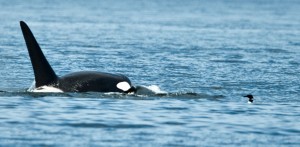 and it was all possible because of this connection with other whale observers and researchers!
and it was all possible because of this connection with other whale observers and researchers!
Read More
Beam Reach is coming to an end. Before I got here, I never imagined how much would be packed into ten weeks. We have learned so much in science, sailing, and life.  I will most treasure all the people we have met. From experts in the field like David Bain to experts in the kitchen like the talented Leslie Veirs, we have met so many new faces.
The last two weeks on the boat we had two guests. Andrea Buckman came on board to tell us about her work with persistent organic pollutants (POPs) in both salmon and killer whales. Living in Canada, she focuses on the Northern Residents, but has been able to use her work to make predictions on effects of POPs on the Southern Residents.  We got to give a little back by showing her J-pod! Always a treat.
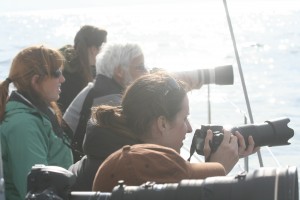
Ally, Val, Mandy, Andrea, and Carlos watching J-pod
Unfortunately for our second guest, Julie Woodruff, we could not deliver the whales, despite all the positive energy we tried to send out. We still had a fantastic time. We were however able to have a discussion on communication on the bow of Gato Verde traveling through Haro Strait. We tried speculate why matriline group structure would be beneficial to the Southern Residents. Classes on the water don’t get much better than that! Julie is finishing her PhD at Berkley and has been coming to the islands to enjoy the whales and water for many years. She studies tuco-tucos, patagonian rodents, to understand stress in group-living and lone females.
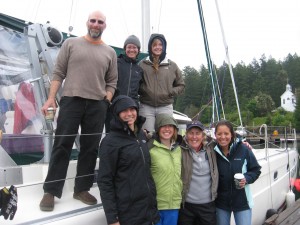
- Our group with Julie
Our guests have shared their work and wisdom. We have been able to tie together many aspects of these whales lives. Thank you to all those who came to share their knowledge with us in these ten weeks. We couldn’t have done it without all of you.
~Emalie
Read More
 Picture 2: Both wild and hatchery juvenile Chinook can be found in the San Juan Islands, as our Beam Reach class found out while beach seining on Lopez Island. The hatchery salmon had their fins clipped for identification.
Picture 2: Both wild and hatchery juvenile Chinook can be found in the San Juan Islands, as our Beam Reach class found out while beach seining on Lopez Island. The hatchery salmon had their fins clipped for identification.




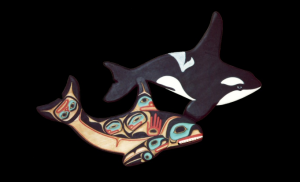









 Twitter
Twitter LinkedIn
LinkedIn Facebook
Facebook